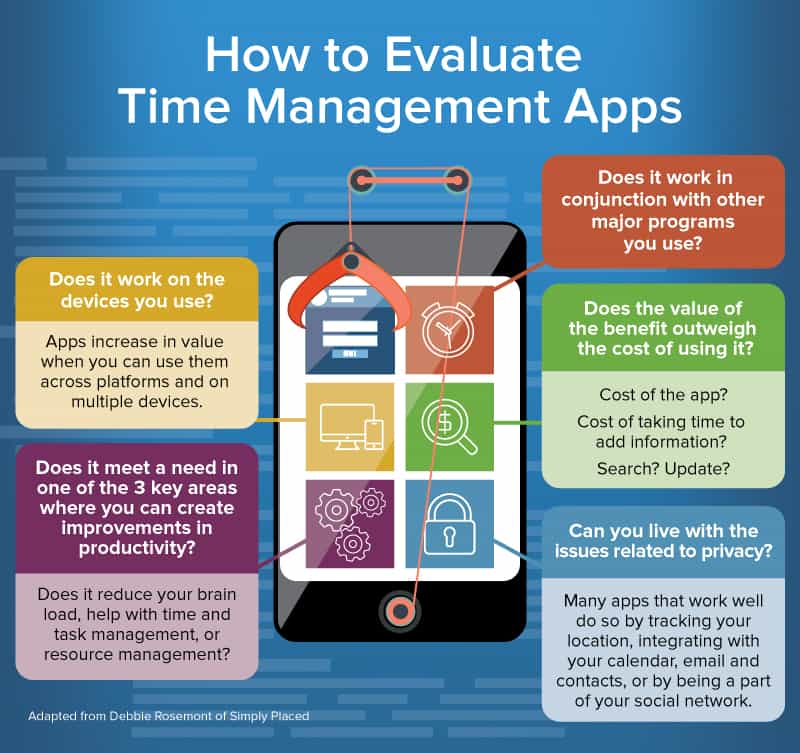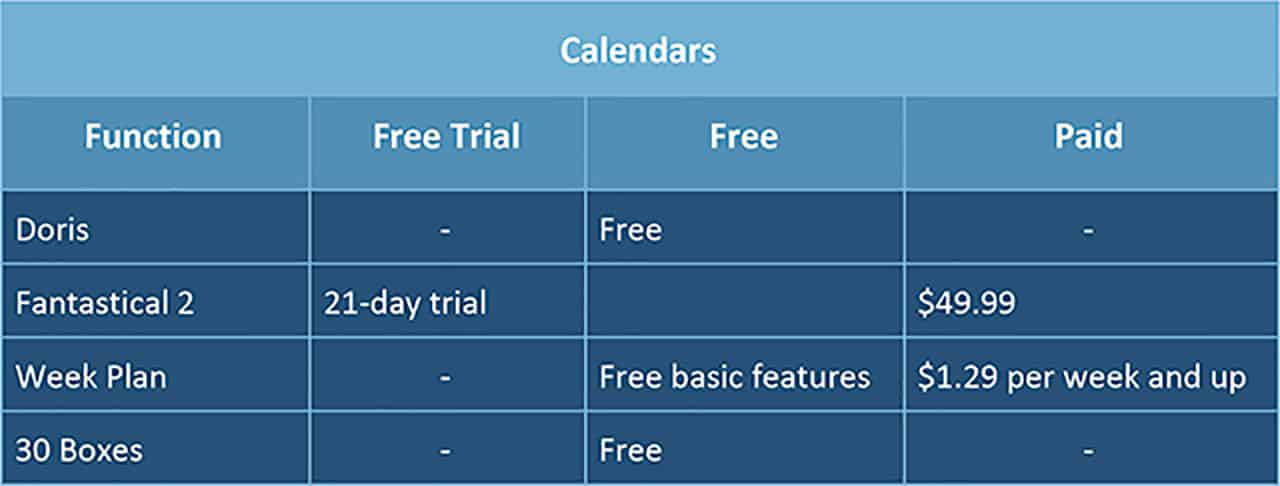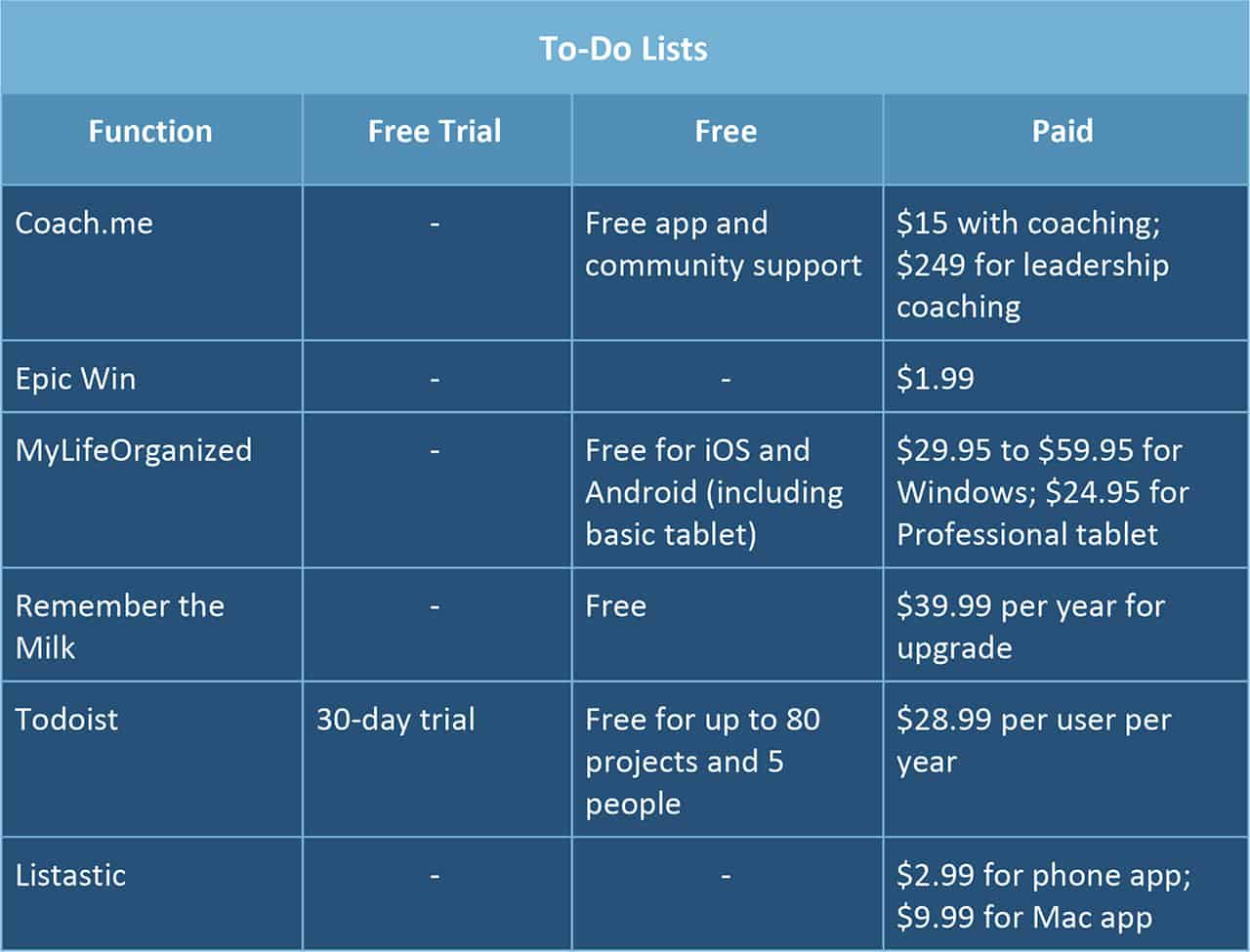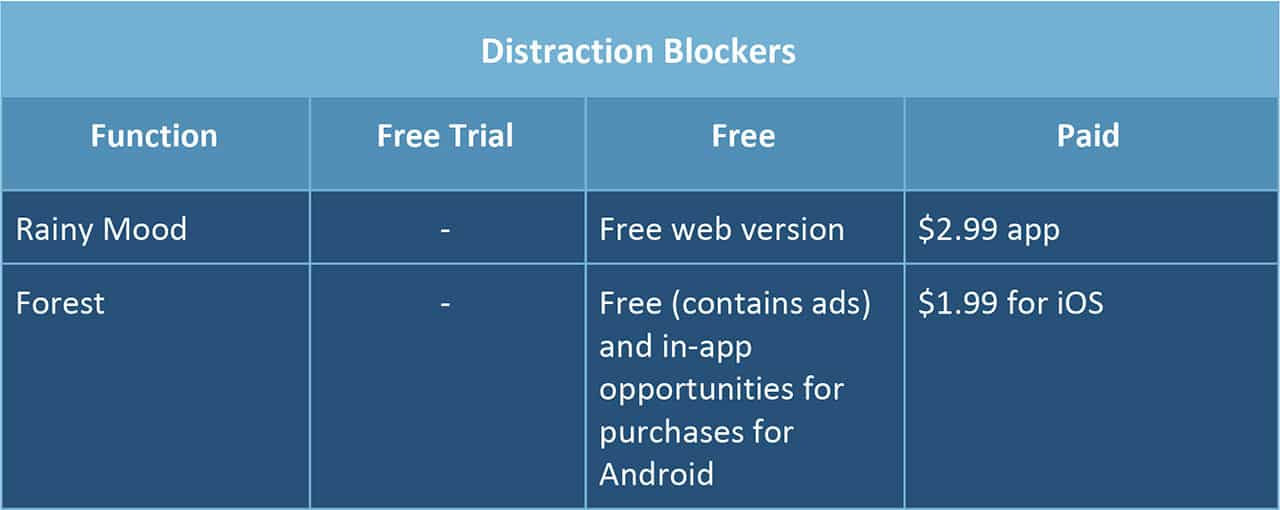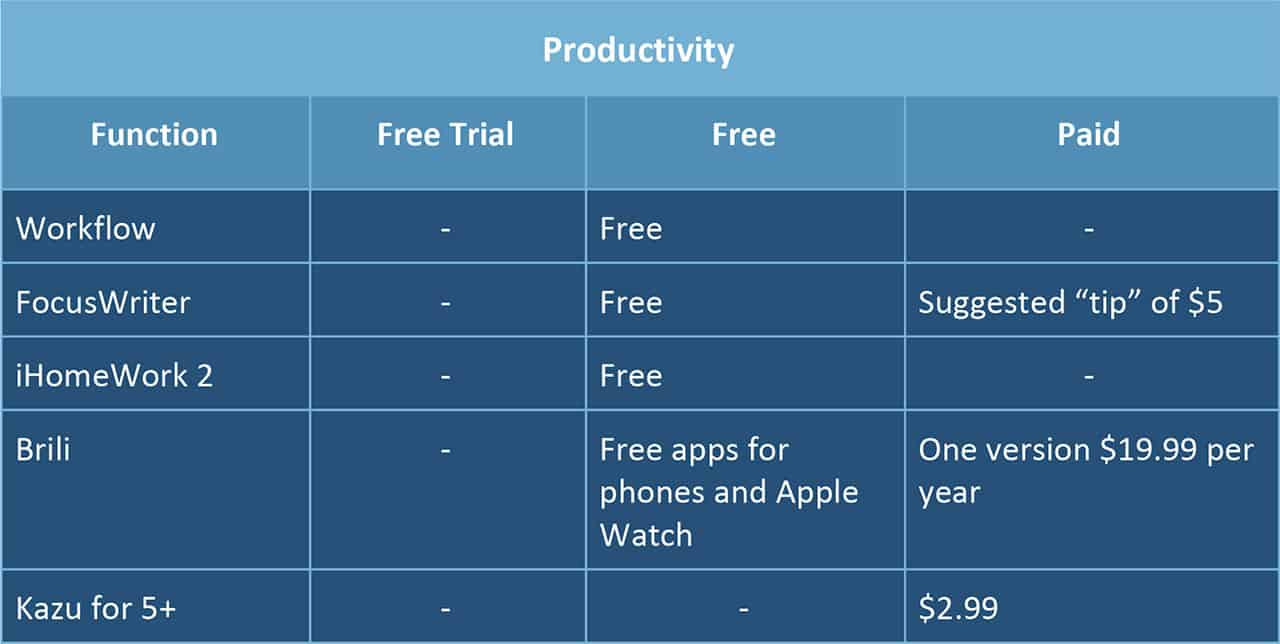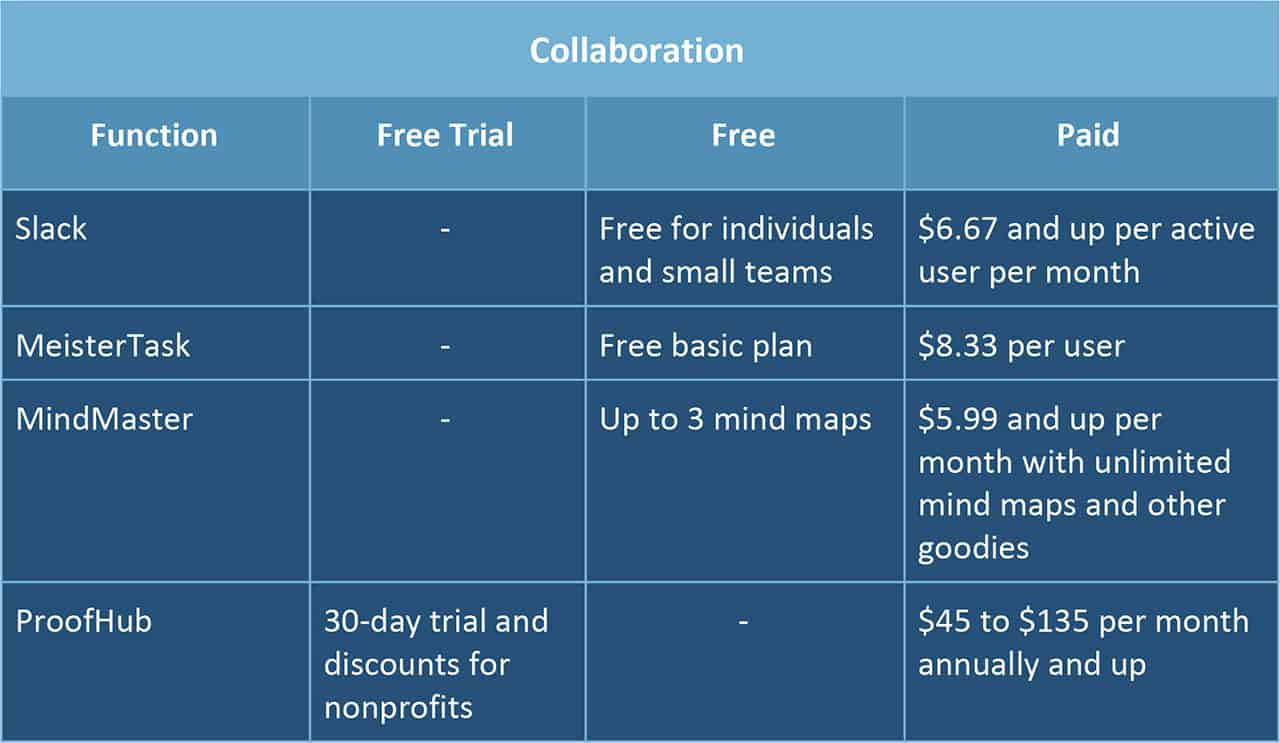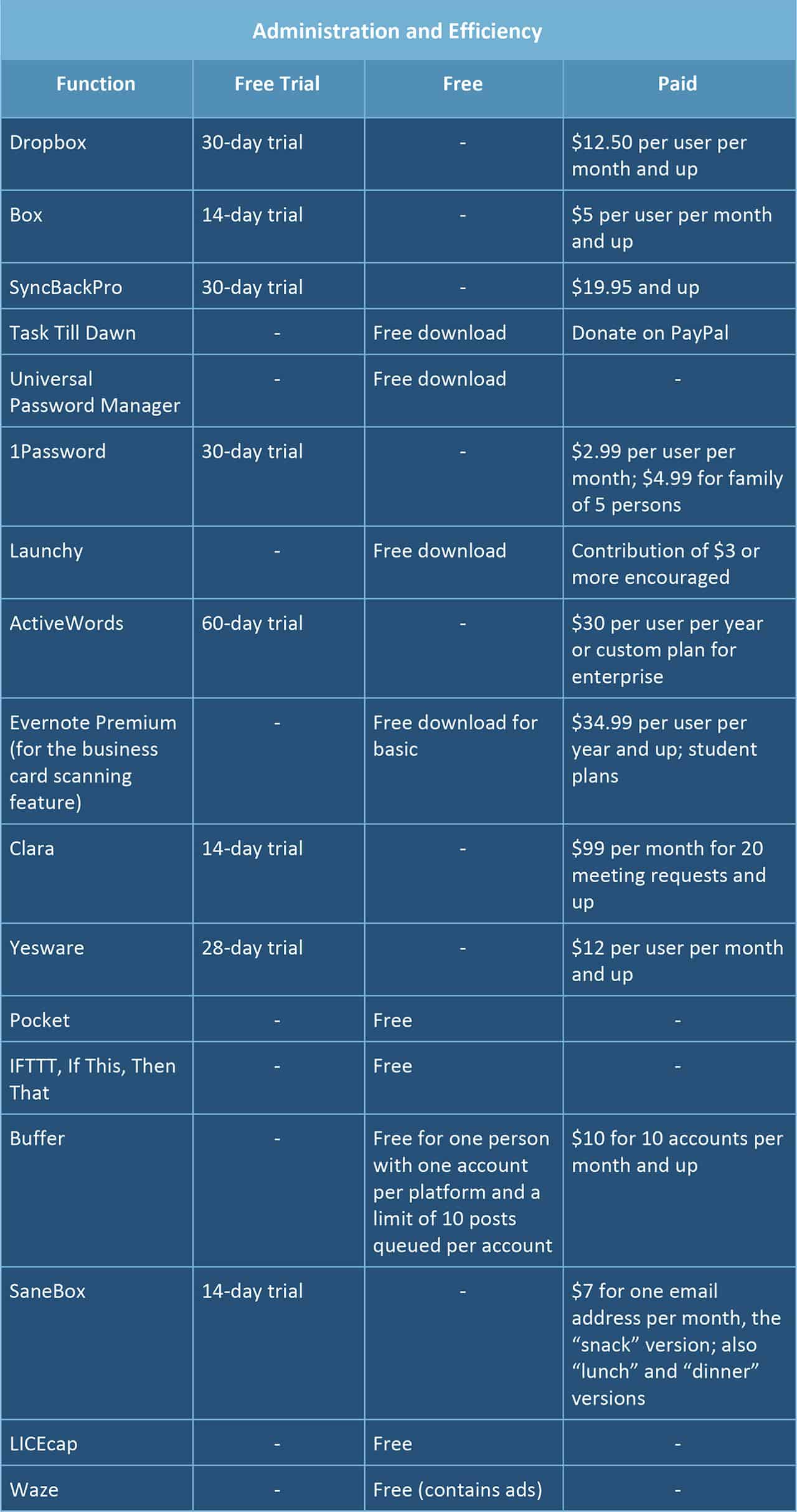How Do You Manage Your Time?
Just as the best word processing program won’t win you a Pulitzer prize, an app or tool can only take you so far.
However, before you spend money or time and effort to learn and set up tools, you need to establish good time management habits. “You can’t rely solely on the app to perform magic. You have to have good habits in place,” Rosemont adds.
After auditing your time, you must decide on the best way to spend it. “It’s not the fact that you don’t have a time management tool. It’s that you aren’t doing what you need to do with the time. No tool’s going to help you if you’re regularly down a rabbit hole,” Gunnis adds.
Dimeo also suggests that everyone — students, executives, and workers — review their to-do list every evening to prepare for the next day. If a task on your to-do list doesn’t support your goals, “You should not be doing it. Period. Of course, all this takes discipline. And, discipline is hard to come by. I wish I could teach it. Fun is easier than work,” he says.
Time Management Methods
Most time management tips and methods are variants of a few basic practices that you can follow with simple, analog tools, like pencil and paper: You need to keep task lists, you need to prioritize, and you need to add things to your calendar. When planning, you also need to pick a time and date, write down your goal, and not leave it as a vague hope. (Check out this helpful resource devoted to time management tips.)
In addition to the basic rules mentioned above, here are some of the many time management methods detailed in books and on websites:
- 1-3-5 Method: A to-do list and prioritization system in one, 1-3-5 asks you to complete one major task, three medium tasks, and five simple tasks on a daily basis. The 1-3-5 method even has its own software.
- The 7-Minute Life Daily Planner: This method says that you can achieve strong planning by spending just seven minutes in the morning and seven minutes in the evening planning for the current and next day.
- Autofocus: Make a list. Then, read through it. Go back and scan the list until you find a task you want to work on. Work on it for as long as you can or want to. If you finish it, cross it off. If you don’t, add it to the bottom of the list. Now, scan the list for something else you’d like to work on. Working in this manner, you should be able to pick your way through a fair pile of to-dos.
- 52-17: Based on extensive studies, this method states that the most productive people work for 52 minutes in an hour and don’t work for the next 17. The 52-17 method offers an app with a timer, among other functions.
- Tickler Files: For people who like the tactile quality of paper files, this system lets you create 31 folders, each representing a day of the month, plus 12 more, each corresponding to a month of the year. This way, you can file items by the future date on which they require action. Arranged by time sensitivity, this system guarantees you won’t miss a deadline.
- Don’t Break the Chain: This approach ensures that you do something goal-oriented every day, so you don’t break the chain. Get a calendar. Write your goal in the space representing the last day of the month. Then, cross off every day that you take a step toward that goal.
“Whatever practice you follow,” says Rosemont, “the trick is to do it consistently.”
To read about more methods and variations that might suit your personality and circumstances, check out A Detailed Guide to Time Management Skills and Techniques.
What to Look for in Time Management Tools and Apps
Ultimately, the “best” time management tool is the one you’ll use. “It has to be convenient and inviting to use,” says Rosemont. “I know some people who look for very aesthetically pleasing paper planners. If they’re going to use something every day, they want to feel happy using it.” However, if you like electronics, you might find using paper a challenge.
Both the old and the new have their advantages. Digital apps are often cloud based, so you can access them wherever, whenever, and often on any device. Paper, on the other hand, doesn’t require WiFi or electricity.
Still, Winterstein believes that paper and pen can never provide the feedback on usage that an app can. “We don’t only mismanage time when we spend it in big chunks. Most often, we mismanage time in small, two or three-minute increments. These do add up really quickly, but we’ll never be bothered to write them down on paper. A good, automated app will give us the level of detail pen and paper won’t,” she adds.
According to Gunnis, you need to decide if you’re going to combine personal lists and calendars with work lists and calendars. “I run my personal stuff and my work stuff together. It just makes it a lot easier for me, rather than having multiple tools,” she says.
You must also consider what exactly you want an app to do. “You need to write down all the things you might want from a tool or an app,” Gunnis says. “I think we’ve all bought apps that we don’t really use.”
Above all, you need to be in control of the acquisition process. “Choose wisely,” cautions Rosemont, “Don’t let the app manage you.” Rosemont offers the following evaluation chart to help you choose the best time management app for your needs.
Free Time Management Apps
Many time management applications are either available for free or offer a free trial for paid tools or subscriptions. Free is great, but Winterstein offers a few caveats regarding free tools. “As the saying goes, ‘Nothing good comes free.’ If an app is free, it means it’s either very basic, or it’s there to generate revenue in some way. The question you should ask yourself when downloading a free app is, ‘What are these guys going to do with my data?’”
Time Management Apps That Work Offline
For those who have to work without WiFi (such as a long plane or car ride), there are several apps that will sync your offline work. The time tracker Toggl and to-do list manager Remember the Milk syncs offline, and RescueTime logs your online usages but lets you manually add details regarding offline usages. You can also consider a good old paper planner, such as one of these beautiful designs from Filofax.
Time Management Apps for iPhone
Time Management Apps for Mac
There are a variety of options for Mac users. Doris offers a calendar and to-do list integrated with iCal, so the app is available across your devices. It includes prioritization capabilities and notes. Workflow lets you combine the functionality of your apps “into a single tap,” as their website says. OfficeTime provides time tracking and invoicing on your iPad, iPhone, and Apple Watch. And, if you need a calendar app, Fantastical 2 offers day, week, month, and year views, plus natural language entry and geofenced and time-based reminders.
Time Management Apps for Android
Sometimes, you need a big picture view to practice good time management. Week Plan, the online app for desktop and Android, offers this with a 7-day view that can include color-coded goals and a “parking lot” that contains potential future tasks and ideas. For a voice-controlled app that works without removing it from your pocket, Timesheet bundles voice activation with time tracking and reporting and has project management features.
Time Management Apps for High School and College Students
High school can be a busy time - students often balance multiple classes, numerous homework assignments and quizzes, preparation for the SAT exam, and extracurricular activities (not to mention family and fun). Therefore, a to-do list is a must-have for teens, and there are several options that include a gamification element to incentivize use. Finish is an online task list that provides the satisfaction of rewards for each item you complete. iPhone users can complete tasks while having fun by playing a role in EpicWin. For each completed task, a user gets a credit to embellish their EpicWin character. What about getting a little help from your friends and neighbors? Coach.me promotes itself as not just a task tracker, but a habit builder. State a goal and get encouragement from an entire community.
In addition to tracking time and scheduling, applications can keep students organized, making for a lighter school work load and therefore, more free time. To take notes, set reminders, and remember web pages for essay and project research, try Evernote.
Anna Winterstein sees the time management tool needs of college students as different from those of high school students: “At a university, it can be very hard to organize your time properly.” She says, “You leave your well-delineated high school world behind and jump into the big pool of adulthood. That’s quite a learning curve! What’s important is to get an app that will track your time holistically and nudge you in the right direction when you’re doing something wrong. Are you really sleeping enough? Should you be investing time in your fitness? Can you save travel time or shift your schedule around to work more efficiently?”
With so much going on in their lives, students may need a structure for breaking big projects into manageable chunks and finding periods of focus. Created by a student, the Pomodoro Technique uses 25-minute periods of work separated by short breaks. Focus Booster provides a desktop Pomodoro timer and includes time tracking and reports to reveal productivity.
Stress and distractions also make it difficult to study or perform other work. Software can help. Focus@will uses auditory neuroscience and psychoacoustics to tune out the distracting stuff while keeping your brain interested, so your mind doesn’t wander. Rainy Mood offers calming natural rain and thunder sounds to shut out the cacophony of modern-world noises.
Time Management Apps for Teens, Tweens, and Tykes
Although privacy is a concern with any mobile or web-based program, it’s of particular concern when considering teens, tweens, and their younger siblings. Gunnis recommends verifying how apps capture and store your kids’ data. Check to see if you can monitor app use and lock out certain data and websites. Once you’ve taken these steps, you and your kids can enjoy the benefits of time management software that’s geared to them. Kids get engaging design and gamified incentives to manage their busy schedules (school, sports, playdates, etc.) while also learning good time management skills. Here are some of the most popular time management apps for this age range:
- In KazuTime, you set the timer and watch a customizable sled dog and puppy race to indicate the passage of time. The puppy winning the race is the reward. (Parents can also choose to offer another prize.) At any age, it’s a lot more fun than watching numbers go by or bars grow or shrink. Brili gets children ages 2-12 organized and out the door in the morning and guides them through the rest of their day with visual and audio prompts. Kids can redeem accomplishment points for parent-selected rewards.
- With iHomeWork 2, students plan to finish homework when they want to, not when it’s due. Notifications remind them of due dates, and a sophisticated task manager allows users to break projects into smaller, more manageable chunks.
- Forest acts as a timer for younger children and as a distraction blocker and device-use tracker for older children and adults. Set a time, and the app plants a virtual tree. If you click out of the app, the tree dies. If you stay focused, the tree grows. With Trees for the Future, you can grow an entire forest to earn virtual coins. Spend these coins to plant real forests.
Time Management Apps to Help with ADHDTime Management Apps to Help with ADHD
If you live with ADHD, you may need a little extra support to get things done. Online tools exist to do just that. Listastic for iOS organizes tasks as active, later, and completed and lets you color code items for easy identification. Priority Matrix uses an Eisenhower Box as a visual tool to help you decide what must be done next and what can wait. Customize the size and color of the boxes to suit your taste.
Time Management Apps for Boomers
Does color-coding help you organize things? Try Todoist to create and share lists, and filter and search for items easily. Create your grocery lists and even set reminders to take your meds. What about all those passwords to your accounts and programs? You don’t need to remember them (or write them on a sticky note on your monitor) - 1Password keeps track of them all. In addition, the app allows you to keep digital documents safe from prying eyes while you’re traveling across borders by locking documents in a “vault.” Then, open it again when you get to your destination.
Time Management Apps for Team Collaboration
Time management isn’t just an individual endeavor. Teams need to talk, share, and move files easily and quickly. The Slack platform is great for real-time direct messaging. If you need to delegate, MeisterTask creates checklists that share updates as team members complete items. Try MindMaster for presentations and collaborative mind mapping. With ProofHub, track time as you view work on boards and monitor workflows. It also allows you to chat, save discussions, and create reports and Gantt charts all in one platform.
Time Management Apps for Organization
Simply becoming more organized can help you manage your time. Think of the peace of mind that comes from reaching for whatever you need, rather than frantically searching for it at the last minute. In addition, capturing ideas in one reliable place means you don’t have to carry them around in your brain and risk forgetting them. Rosemont stresses the importance of one “collection point” for tasks and files, whether that point be electronic or in print. This concept becomes even more crucial when collaborating with others. Here are several key ways to organize your files:
- File Sharing: Spare yourself the trouble of sorting through email attachments, and instead use a more organized, centralized file repository. “We file to take action and for reference,” Rosemont points out. You need one safe place that everyone can access, even remote workers. Dropbox is an example of a program that takes files of all sizes and stores them in one accessible location.
- Safeguarding Files: You protect files not just through your antivirus program, but by backing up your system and storing redundant copies of files. Filesharing platforms can help you do this, but so can a dedicated backup and sync program like SyncBackPro.
- Inbox Rules: Your email program probably already has rules to help you sort content, such as different types of videos. Use them. Or, get extra sorting power from SaneBox.
Time Management Apps for Productivity
A bevy of app options exists to aid your productivity, which in turn saves you valuable time so you can focus on other, more important things.
- Calendars: Calendars not only capture to-do-list items, but show you an overview of your life for a day, week, month, or even year. For a calendar app, look for cross-platform compatibility and sync capability to accommodate your many devices (and possibly those of others with whom you share calendar items). 30 Boxes is one option for productivity and sharing. The trick is to remember to update your calendar regularly. “Feed the beast, and it will work for you,” says Rosemont.
- Alarms and Timers: Alarms and timers serve your time-monitoring needs in many ways. They help you wrap up meetings, and give you periods of focused work during which you don’t have to look at the clock because the beeper sounds when it’s time for you to move on to the next task. The tools are all around you — in smartphones with alarms and timers, in watches with stopwatch and timer capability, and in the onboard timer on your laptop or tablet. If you want something purpose-built, find it in web-based timers, such as Tomighty, a Pomodoro Technique timer.
- Task Lists: What if you could keep a four-level task list for up to 80 projects, share tasks, and track your productivity, all in one app, for free? Check out Todoist. What if your list could recognize your location and remind you? MyLifeOrganized does based on the Getting Things Done method, which contextualizes tasks.
- Focus-Based Software: Software can help you stay focused. Freedom’s StayFocusd allows you to stop websites that lure you away from work most often. And, when you’ve really got to write, FocusWriter fills your desktop with an empty page to keep you focused. Set timers to ensure you spend that designated hour getting thoughts on the page, and customize the look of the page to suit your content. You can even set a visual focus tool to block out everything else on the screen but your current paragraph.
- Schedulers: These tools allow you to schedule program maintenance, such as backups or updates, in advance. Scheduling backups and other activities can save you effort and time, as many programs complete multiple tasks during silent hours. Even if your program doesn’t have a scheduling capability, an app like Task Till Dawn may help. Scheduling programs open and run activities at specified times, giving you one less thing to hold in your mind.
- Password Keepers: Do you waste time trying to remember the correct password for that image editing program you use twice a year? Why not store it in a password-keeping program, like Universal Password Manager? Not only do these programs help you remember, they help you keep your programs safe from hacking by allowing you to create more complicated passwords without fear of forgetting.
- Shortcuts: By now, certain keyboard shortcuts are universal. However, some apps extend shortcuts beyond those you already know and even configure programs to open to your specified defaults. Such things are possible when you exploit the native capability of your device and bring in the power of a program like Launchy, a storehouse for macros.
- Boilerplate: If you send the same message frequently, your email or word-processing program might have templates. ActiveWords allows you to call up boilerplate text with a few keystrokes.
- Bunches of Business Cards: When those business cards collect in little containers on your desk, scan them through Evernote Premium to upload them to LinkedIn.
- Remind Me: Add your events to an online calendar, and myMemorizer will send an SMS message or email to your mobile phone.
- Let Clara Do It: Earlier, we met Doris. Now, meet Clara. Using machine learning, Clara integrates with your calendar to find convenient meeting times for everyone on your invitee list, so you don’t have to.
- Sell, Sell, Sell: Do you send out email letters of intent and sales pitches? With Yesware, you can track your versions, and see who’s opening your email(s) and attachment(s) in real time.
- So Many Good Reads, So Little Time: Use a special program to save and store interesting links for after you complete your to-dos, when you have time. Evernote offers a Web Clipper add-on. Sign up for Pocket to save articles and videos, and also have a curated list of “the best on the web” sent to you weekly.
- Automate: IFTTT, If This, Then That is a free platform to automate actions, such as turning on your HUE light bulbs as you approach home or sending you a text message at the same time everyday. Use it by creating the simple conditional statement if this, then that, through services such as Amazon Alexa, Slack, and many others.
- Link that Social: Buffer connects social media accounts, so you can schedule posts and push them to all your social media accounts.
- Camera. Action! A picture paints a thousand words. A movie captures even more. Free, easy-to-use LICEcap makes animated GIFs for demos and captures bugs to convey ideas efficiently and effectively.
- Make Life Simpler: Time-saving apps aren’t just for lists, files, and office communications. What about a traffic update app that offers alternatives to congested routes or advises you when to leave based on current conditions? Rosemont suggests Waze. Online bill pay? Ask your service provider, or sign up for it as part of your online banking services. Doing research? Explore your public library’s online resources. Want to save money on everything from groceries to getaways to garden maintenance? Check your favorite vendors’ websites, or sign up on a coupon site like Groupon.
Free and Paid Time Management Apps
A surprisingly large number of free apps exist, some for OX and iOS, some for Android and Windows. Many have strong customer reviews, too. Use this matrix to find the app that meets your needs.
Use Smartsheet to Manage Your Time More Effectively
Empower your people to go above and beyond with a flexible platform designed to match the needs of your team — and adapt as those needs change.
The Smartsheet platform makes it easy to plan, capture, manage, and report on work from anywhere, helping your team be more effective and get more done. Report on key metrics and get real-time visibility into work as it happens with roll-up reports, dashboards, and automated workflows built to keep your team connected and informed.
When teams have clarity into the work getting done, there’s no telling how much more they can accomplish in the same amount of time. Try Smartsheet for free, today.




